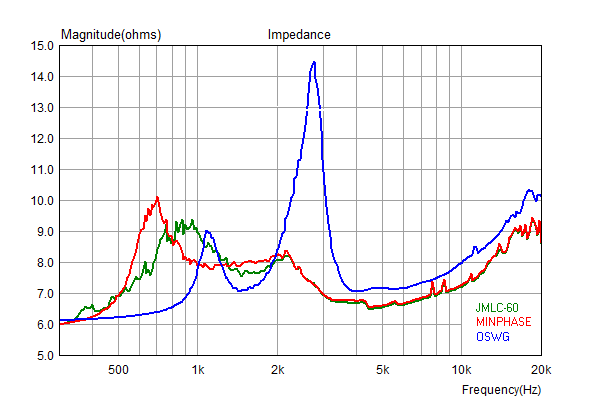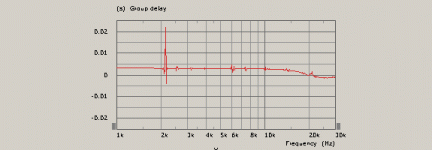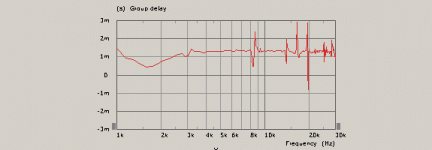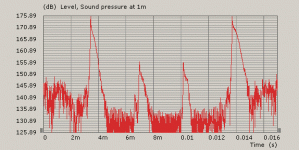Ahh - uumpf - grrr - huuu - GOT IT !
- and the light blue for sure is a OSWG for reference - where did I have my thoughts...
These are beautiful graphs!
The very narrow peak in blue is likely a diaphragm resonance or other resonance within the driver. With such a high Q that is about the only choice.

http://www.diyaudio.com/forums/mult...man-diy-show-gelsenkirchen-2.html#post2101977
Last edited:
So may I suggest you take any horn and do this kind of curve and then stand out in front of your horn about 1 meter with a 30cm square piece of cardboard and position the cardboard perpendicular to the axis of the horn and look at the Z curve. Now tilt the cardboard at some angle and see the changes in the curve again. The region the horn does not change Z much with this test is the region where the horn is making a good match. This test is for a tweeter horn used above 1kHz. For lower frequency horn use bigger cardboard and stand further away. Anyone who does this will learn more than they want to know about horns.
This sounds interesting (at least as much as the towel trick ..) – are you suggesting to intentionally reflect sound back into the horn ?
And what can be learned form that experiment – I didn't get the point I'm afraid ?
Michael
I really can't remember which is which at the moment. But you know, I would try and go for flat acoustic impedance as possible while trying to maintain a certain level of directivity control. I won't focus on the narrow dips and peaks at the moment.Ahh - uumpf - grrr - huuu - GOT IT !
These are simus !
Ok.
- and the light blue for sure is a OSWG for reference - where did I have my thoughts...
- the dark blue and is one of your earlier works with the wiggle in the 15kHz range
How many points for the candidate ?
##########
Seriously - can you explain a little bit ?
Michael
Regarding the flat response you posted somewhere, it's possible the acoustic impedance becomes higher in the upper frequency range. My sims show this trend.
Any of the traces in the plots that refer to this trend you noticed ?
Michael
This sounds interesting (at least as much as the towel trick ..) – are you suggesting to intentionally reflect sound back into the horn ?
And what can be learned form that experiment – I didn't get the point I'm afraid ?
Michael
Yah I left a lot out. Yes just make a simple boundary with the cardboard. In the region where the Z curve changes very little the horn is a good match from compression driver to air. In the regions where the Z curve changes a lot then the horn is not such a good match.
Back to the 4"x10" horn... at 10 feet in the bad region it would change part of the curve dramatically. So when used for audio it seems to me that region is useless. Z must be stable in this test for the response to be stable. That is it.
Wish I could find a better compression driver with wider bandwidth....Always liked the looks of the Altec 802-8G but those things are now many hundreds of dollars. Known as the "tangerine" driver. Oh well.
You can get the new GPA Altec ones for about $200 each for the 902-8A
Great Plains Audio's HF Drivers
I'm sort of looking into maybe trying to build a version of the Altec M-19 using those.. Not sure on what horn to use? Either try one of these Waveguide style types, or go with an original set of Altec 811-B horns..
Dave
Good compresion driver and bad horn...
Interesting tip on the driver- thanks.
I see Great Plains supply the ultra evil dual rate "honks like a train" horn. Avoid those awful things. The theory behind them is bad as is the sound. Just look for a sudden change in the flare rate as in a sudden bend in the flare inside the horn.
I have not played with the waveguide stuff yet. From what I see it looks "curious." If you saw my earlier post about honk then this may not. On the other hand loading of the driver would be very low so output before over excursion will be equally low. Fine for home maybe but no good for PA.
The driver and horn combo from Parts Express will play 127dBa at one meter before going into 3rd order intercept power compression. That means at reasonable levels distortion should be low but have not measured it to date.
Good luck with your horn project. My cabinets are coming together today!
You can get the new GPA Altec ones for about $200 each for the 902-8A
Great Plains Audio's HF Drivers
I'm sort of looking into maybe trying to build a version of the Altec M-19 using those.. Not sure on what horn to use? Either try one of these Waveguide style types, or go with an original set of Altec 811-B horns..
Dave
Interesting tip on the driver- thanks.
I see Great Plains supply the ultra evil dual rate "honks like a train" horn. Avoid those awful things. The theory behind them is bad as is the sound. Just look for a sudden change in the flare rate as in a sudden bend in the flare inside the horn.
I have not played with the waveguide stuff yet. From what I see it looks "curious." If you saw my earlier post about honk then this may not. On the other hand loading of the driver would be very low so output before over excursion will be equally low. Fine for home maybe but no good for PA.
The driver and horn combo from Parts Express will play 127dBa at one meter before going into 3rd order intercept power compression. That means at reasonable levels distortion should be low but have not measured it to date.
Good luck with your horn project. My cabinets are coming together today!
No.Any of the traces in the plots that refer to this trend you noticed ?
Michael
The one that I recall having 3db slope had an acoustic impedance hump between 5K~10K
Eighteen Sound driver
.
ND1018BT - HF Neodymium Transducer
.
Or, the ferrite version for $120.
.
HD1050 - HF Compression Driver
I am thinking of springing for the Eighteen sound ND1018BT for $160.00 each.Wish I could find a better compression driver with wider bandwidth....Always liked the looks of the Altec 802-8G but those things are now many hundreds of dollars. Known as the "tangerine" driver. Oh well.
.
ND1018BT - HF Neodymium Transducer
.
Or, the ferrite version for $120.
.
HD1050 - HF Compression Driver
Sumaudio - which Dayton horn are you using? The only Dayton "horn" with screw I see is the Dayton H110. The 2 bolt horn Dayton H812 "looks" better and of course would fit the 2 bolt Altec type drivers.
FWIW, I have the Altec 802 and 806 drivers. To me the 806 is clearly better for hi-fi. Much smoother, less shouty. But I believe that is mostly because the 802 has the Symbiotic diaphragm. I don't like 'em.
What driver are you using?
FWIW, I have the Altec 802 and 806 drivers. To me the 806 is clearly better for hi-fi. Much smoother, less shouty. But I believe that is mostly because the 802 has the Symbiotic diaphragm. I don't like 'em.
What driver are you using?
horn and driver
 ayton H110 1" Constant Directivity Horn 90x40 1-3/8"-18 TPI | horn lens horn tweeter horn bell horn compression driver
ayton H110 1" Constant Directivity Horn 90x40 1-3/8"-18 TPI | horn lens horn tweeter horn bell horn compression driver
is the horn and have chosen the eminence driver
Parts-Express.com:Eminence PSD:2002S-8 1" Titanium Driver 8 Ohm 1-3/8"-18 | compression driver tweeter horn driver screw on high frequency 1" exit i" throat HF PA driver tweeter driver
Why did we choose this driver? In phase. Being in phase is far more important than being flat. Out of phase cannot be fixed. Fixing flatness is easy. There are many that have wider frequency response and so on but none that we found that stay in phase over a wider frequency range. The felt ring I talked about completely eliminated any honking. Best horn ever so far.
The big smiley is some artifact of the auto parse feature. Think the link still works.
Parts-Express.comSumaudio - which Dayton horn are you using? The only Dayton "horn" with screw I see is the Dayton H110. The 2 bolt horn Dayton H812 "looks" better and of course would fit the 2 bolt Altec type drivers.
FWIW, I have the Altec 802 and 806 drivers. To me the 806 is clearly better for hi-fi. Much smoother, less shouty. But I believe that is mostly because the 802 has the Symbiotic diaphragm. I don't like 'em.
What driver are you using?
is the horn and have chosen the eminence driver
Parts-Express.com:Eminence PSD:2002S-8 1" Titanium Driver 8 Ohm 1-3/8"-18 | compression driver tweeter horn driver screw on high frequency 1" exit i" throat HF PA driver tweeter driver
Why did we choose this driver? In phase. Being in phase is far more important than being flat. Out of phase cannot be fixed. Fixing flatness is easy. There are many that have wider frequency response and so on but none that we found that stay in phase over a wider frequency range. The felt ring I talked about completely eliminated any honking. Best horn ever so far.
The big smiley is some artifact of the auto parse feature. Think the link still works.
Examples of pure evil in a horn
Parts-Express.com:Goldwood GT-300PB 1" Horn 1-3/8"-18 TPI | horn lens horn tweeter horn bell horn compression driver horn
Parts-Express.com:Eminence H295 1" Constant Directivity Horn 90x40 2/3-Bolt | horn lens horn tweeter horn bell horn compression driver
Go here and see these horns with the sudden change in flare rate. That is pure evil in a horn and makes them honk and snap so bad that anyone with an ear will wonder what that sound is. BI-radial and all that is fine so long as the flare is smooth and continuous. When you see that sudden change as these two horns have there is one thing for certain- it will always sound bad.
Parts-Express.com:Goldwood GT-300PB 1" Horn 1-3/8"-18 TPI | horn lens horn tweeter horn bell horn compression driver horn
Parts-Express.com:Eminence H295 1" Constant Directivity Horn 90x40 2/3-Bolt | horn lens horn tweeter horn bell horn compression driver
Go here and see these horns with the sudden change in flare rate. That is pure evil in a horn and makes them honk and snap so bad that anyone with an ear will wonder what that sound is. BI-radial and all that is fine so long as the flare is smooth and continuous. When you see that sudden change as these two horns have there is one thing for certain- it will always sound bad.
I am interested in what anyone would have to say about these group delays from AxiDriver. Can there really be such difference in reality?
That first one looks like a strong resonance about 2.2K so the delay is not determined well.
The second one is the classic flip (invert) phase between 8k and 9k and again about 14kHz and then the group delay measurement shows in and out of phase with increasing frequency.
That first one is 4ms and the second one about 1.3ms.
My BIG question is how this was measured and the "theory" behind the measurement? In most horns the apparent source moves in or out of the throat with changes in frequency. I really suspect this measurement is somewhat erroneous as the lines are to flat except for the areas of wide variation. Were these measurements only the compression driver without the horn?
Hello Soongsc,
On the left one the highest frequencies arrive earlier than the low frequency which is quite normal. The relative group delay of the low frequencies versus the high frequencies (4 milliseconds) is equivalent to a backward displacement of 1,4meter (which is a large value).
About the right one it looks strange to me and doubtful.
Does any group delay curve delivered by Axidriver has been ever compared to the one given by Hornresp (which has been verified by me and others and is fully reliable)?
Best regards from Paris, France
Jean-Michel Le Cléac'h
On the left one the highest frequencies arrive earlier than the low frequency which is quite normal. The relative group delay of the low frequencies versus the high frequencies (4 milliseconds) is equivalent to a backward displacement of 1,4meter (which is a large value).
About the right one it looks strange to me and doubtful.
Does any group delay curve delivered by Axidriver has been ever compared to the one given by Hornresp (which has been verified by me and others and is fully reliable)?
Best regards from Paris, France
Jean-Michel Le Cléac'h
I am interested in what anyone would have to say about these group delays from AxiDriver. Can there really be such difference in reality?
As for now we have :
- soongsc suspecting horn loading
- Jean-Michel suspecting GD
- and me suspecting IM and D-IM
to be the root cause of that strange sonic impact of horns at the lower end of their usable band width.
For me there is no doubt, it's the multi echo between mouth and driver (Acoustical tube) which gives the impression that it is far sound source (temporal sum of back and forth).
So for me it's the group delay.
Listen a tubular horn.
It seems this is a good point. Looking at energy time plots do show some funny echo. The spacing between the echos is the multiple of the first delay time.For me there is no doubt, it's the multi echo between mouth and driver (Acoustical tube) which gives the impression that it is far sound source (temporal sum of back and forth).
So for me it's the group delay.
Listen a tubular horn.
Attachments
Last edited:
Hello Jean-Michel,Hello Soongsc,
On the left one the highest frequencies arrive earlier than the low frequency which is quite normal. The relative group delay of the low frequencies versus the high frequencies (4 milliseconds) is equivalent to a backward displacement of 1,4meter (which is a large value).
About the right one it looks strange to me and doubtful.
Does any group delay curve delivered by Axidriver has been ever compared to the one given by Hornresp (which has been verified by me and others and is fully reliable)?
Best regards from Paris, France
Jean-Michel Le Cléac'h
I am not sure whether AxiDriver is totally correct, and I have found a few areas that did not look quite right and have reported them as bug. But there seems to be some relation between group delay and acoustic impedance. I wonder whether anyone has explored this mathematically?
- Status
- This old topic is closed. If you want to reopen this topic, contact a moderator using the "Report Post" button.
- Home
- Loudspeakers
- Multi-Way
- Horn Honk $$ WANTED $$



